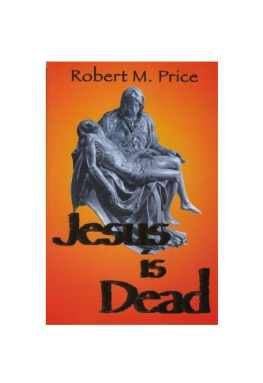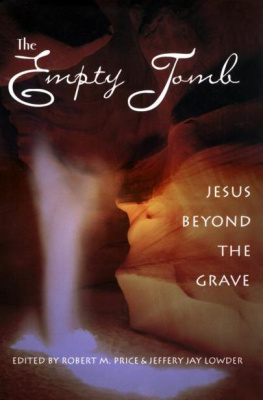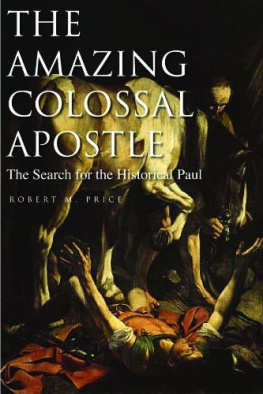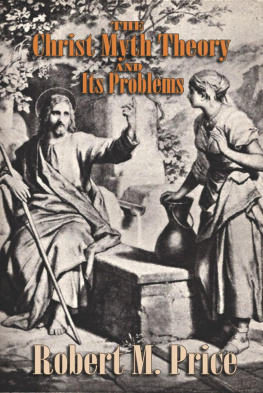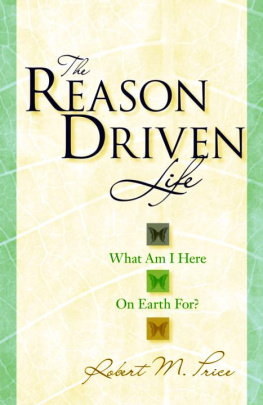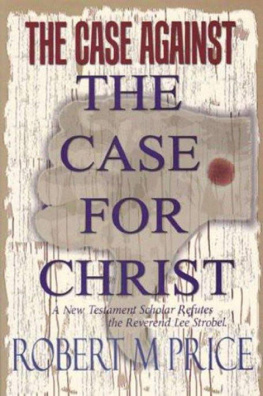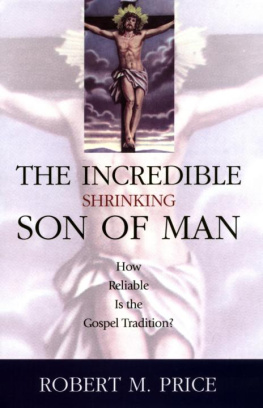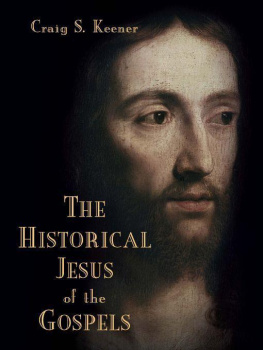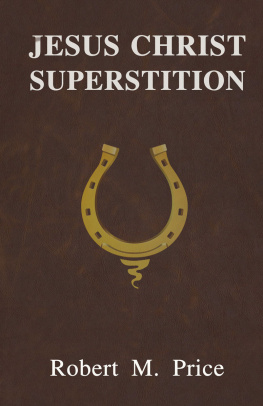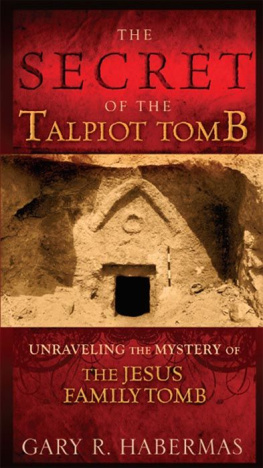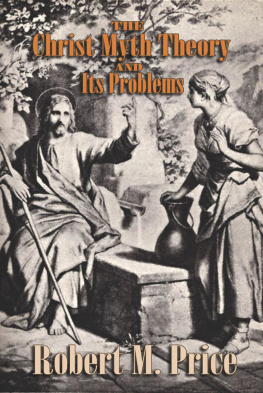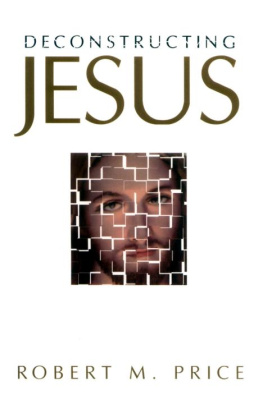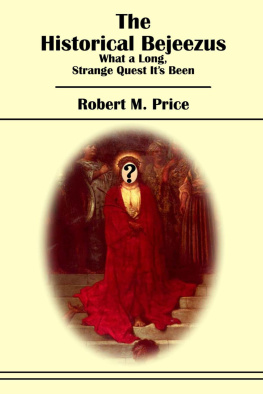Robert M. Price - Jesus Is Dead
Here you can read online Robert M. Price - Jesus Is Dead full text of the book (entire story) in english for free. Download pdf and epub, get meaning, cover and reviews about this ebook. year: 2012, publisher: American Atheist Press, genre: Detective and thriller. Description of the work, (preface) as well as reviews are available. Best literature library LitArk.com created for fans of good reading and offers a wide selection of genres:
Romance novel
Science fiction
Adventure
Detective
Science
History
Home and family
Prose
Art
Politics
Computer
Non-fiction
Religion
Business
Children
Humor
Choose a favorite category and find really read worthwhile books. Enjoy immersion in the world of imagination, feel the emotions of the characters or learn something new for yourself, make an fascinating discovery.
- Book:Jesus Is Dead
- Author:
- Publisher:American Atheist Press
- Genre:
- Year:2012
- Rating:3 / 5
- Favourites:Add to favourites
- Your mark:
- 60
- 1
- 2
- 3
- 4
- 5
Jesus Is Dead: summary, description and annotation
We offer to read an annotation, description, summary or preface (depends on what the author of the book "Jesus Is Dead" wrote himself). If you haven't found the necessary information about the book — write in the comments, we will try to find it.
Robert M. Price was for a time an apologist of the sort he refutes in Beyond Born Again, Deconstructing Jesus, The Incredible Shrinking Son of Man, and Night of the Living Savior. He is also the author of The Widow Traditions in Luke-Acts, The Da Vinci Fraud, The Reason-Driven Life, and the monumental The Pre-Nicene New Testament. He holds a PhD in Systematic Theology from Gordon-Conwell Theological Seminary and a second PhD in New Testament from Drew University. He has served as Professor of Religion at Mount Olive College in North Carolina and is a member of the Jesus Seminar.
Jesus Is Dead — read online for free the complete book (whole text) full work
Below is the text of the book, divided by pages. System saving the place of the last page read, allows you to conveniently read the book "Jesus Is Dead" online for free, without having to search again every time where you left off. Put a bookmark, and you can go to the page where you finished reading at any time.
Font size:
Interval:
Bookmark:
DEAD Jesus is Dead ROBERT M. PRICE
2007
American Atheist Press
Cranford, New Jersey
ISBN-13: 978-1-57884-000-7 American Atheist Press
P.O. Box 5733
Parsippany, NJ 07054-6733
Voice: (908) 276-7300
FAX: (908) 276-7402 www.atheists.org Copyright 2007 American Atheist Press All rights reserved. No part of this publication may be reproduced, stored in a retrieval system, or transmitted in any form or by any means, electronic, mechanical, photocopying, recording, or otherwise, without prior written permission of the publisher, except in the case of brief quotations embodied in critical articles and reviews. Library of Congress Cataloging-in-Publication Data Price, Robert M., 1954-
Jesus is Dead / Robert M. Price.
p. cm.
ISBN-13: 978-1-57884-000-7
ISBN-10: 1-57884-000-7
1. Jesus ChristResurrection. 2. ChristianityControversial literature. 3. Jesus ChristHistoricity. I. Title.
BT482.P75 2007
232.5--dc22
2007008294 Printed in the United States of America
This book is dedicated to
August Berkshire,
An Atheist more Christ-like than Christians
PDF and ebook versions by John F. Felix, jffelix61@att.net
Contents
Introduction Theres no shame in it. Everybody dies. Even great historical figures. Even Jesus. No one will deny that at least if one believes there was an historical Jesus in the first place but thats another can of worms! The issue is, did he stay dead? Everybody else does. Why should Jesus be an exception? But the Christian claim is that Jehovah did make an exception in his case handing him over to the Grim Reaper, yes, but then snatching him back before his corpse was scarcely cool. How does one evaluate such a claim? Insofar as its proponents urge it upon us as a datum of history, we must evaluate the resurrection creed in historical terms. And the verdict I must then return is the title of this book. It is not quite so simple, but I do not want to obfuscate the issue with a haze of religious sentimentality as many do.In the present collection I have assembled some of my best writing and thinking on the resurrection (and in a couple of cases, closely related issues). Easter Fictions was the opening statement in a debate I had at Colorado State University with Dr. Craig Blomberg. The next two, What Can We Know of the Historical Jesus? and Must Jesus Have Risen? are condensed versions of two chapters from my book Beyond Born Again (out of print at the moment). I have found these versions useful in debates with my pal and sparring partner Greg Boyd at UCLA and other venues. I wrote Night of the Living Savior for the 2005 Atheist Alliance conference in Los Angeles. Was Jesus John the Baptist Risen from the Dead? was a Jesus Seminar paper that nearly convinced even the late, great Robert Funk. How Secure Is the New Testament Witness? began as a long answer to a question by my friend Fred Lykes.Templars and the Tomb of Jesus grew out of research I did for another book, The Da Vinci Fraud: Why the Truth is Stranger than Fiction (Prometheus Books). There turned out to be too many related books to survey in that context, but they invited comment anyway, and this seems the place for those comments. I analyzed another bit of pseudo-evidence about Jesus, The Talmud of Jmmanuel , for a course I teach { x } on Modern Gospels. Fundamentalists are not the only pseudo-scholars requiring refutation. I dont accept the dictum that the only heresy is orthodoxy. No, there are plenty of crazy views out there in need of refutation. Why not just ignore them? Why not welcome them as allies in the struggle against reigning orthodoxy? For a very simple reason. If we are offering a credible, viable, even compelling alternative to orthodox beliefs about the Bible, it is important that we be equally impatient with other inadequate treatments of the Bible and Christian origins.If we welcome any old attack on the traditional creeds, we are embodying the caricature (at least I hope its a caricature) drawn of us by our foes, namely that we dislike Christianity just because its Christianity, not because we are really interested in the facts. Well, I am interested in the facts, and I must demonstrate that I am impartial in my scrutiny. I do not target fundamentalist apologetics because I have a vendetta against fundamentalism. Rather, as a biblical scholar, I attack any and all views insofar as they misuse and manipulate the Bible. A Homer scholar would feel the same concern to respond to all fanatical appropriations of the Iliad and the Odyssey (that is, if there were any). Besides, it seems to me that a fundamentalist who relishes a demolition of Holy Blood, Holy Grail may have a harder time laughing it off when the same critical criteria are then applied to his own favorite axe-grinders. What is sauce for Michael Baigent is sauce for William Lane Craig. When I sit down to review a book, I take the opportunity to write something of an essay not only on the book itself but on the wider questions addressed in it. Some of these reviews, I am vain enough to think, feature valuable ideas tucked away here and there. I would like to recirculate them here for something of a wider reading. I have several times been asked to review and critique Internet essays by various apologists, and I have shaped up and polished some of these comments for this book, too. Several major issues central to the resurrection and the origins of Christianity come up for consideration, and I think I have made some interesting points. Heres your chance to consider them.{ xi } I conclude the book with another opening statement, Christ A Fiction, this one for a debate with John Rankin, a fine fellow whom I debated at the Unitarian Church of Montclair.I guess I ought to apologize for the occasional sarcasm scattered through these pages. There is a limit to the degree that I can show politeness without being a hypocrite. You see, I dont want to make an outrageous proposition sound like it deserves any respect by speaking of it respectfully. I dont want to get sucked into that trap.My fellow Atheists, my fellow Bible-lovers, let me commend the humble search for truth, for which, unless we live in a cosmic madhouse, no one will be damned.Robert M. PriceMay 2, 2006 Easter Fictions Enter and Exit the Apologist For some dozen years I was a born-again Christian. I did quite a lot of personal witnessing, and eventually I studied apologetics as an aid to evangelism. I knew I could not argue anyone into the kingdom of God, but if I were well-prepared, I hoped I might help unbelievers get past certain questions that were keeping them from faith. How could I expect them to accept Christ as their savior if it were an open question whether Christ even existed? And so on. I was active in InterVarsity Christian Fellowship, where I devoured the works of many Christian apologists, most of them centering upon New Testament issues, mainly the historical Jesus. I read everything I could get my hands on by John Warwick Montgomery ( History and Christianity [1964], F.F. Bruce ( The New Testament Documents: Are They Reliable? [1960], J.N.D. Anderson, Christianity: The Witness of History [1969] and The Evidence for the Resurrection [1966]), Edwin M. Yamauchi, Jesus, Zoroaster, Buddha, Socrates, Muhammad [1972]), Frank Morison, Who Moved the Stone? [1930]), Ralph P. Martin ( Mark: Evangelist and Theologian [1972]), I. Howard Marshall ( Luke: Historian and Theologian [1970], Josh McDowell ( Evidence That Demands a Verdict [1972] and More Evidence That Demands a Verdict [1975]), and others.These writers compose a mixed bag. Bruce, Martin, and Marshall were all genuine New Testament scholars, but they were half-apologists, what James Barr (in his amazingly insightful book, Fundamentalism , 1976) called maximal conservatives. They functioned within a certain ecclesiastical-academic world in which the traditional seemed always the most plausible. Any theory outside of certain parameters just could not seem worthwhile to them. Thus, while seeming to employ critical arguments and axioms, they always, in virtually every case, arrived at safe conclusions comfortable for orthodoxy. Anderson and Montgomery, though very well read in history and theology, were primarily legal scholars, and they disdained {} what seemed to them the excessively skeptical procedures of professional New Testament specialists. This put them in the odd position of claiming, precisely as outsiders to the field, to know better than the insiders, a stance that comes in quite handy in apologetics, as when a Chiropractor praises himself as being independent of the medical establishment. Morison and McDowell were just hacks, Morison a very imaginative one, McDowell a jack-of-all-trades who mainly amassed research done by students and organized it into syllabi of paragraph-length notes and quotes. Reading the works of all these men, I learned much, some of it valid.As years went by and I augmented what I read from them with my own research, I came to be amazed again and again to discover major items of relevant information, even whole aspects of crucial questions, that I would never have been aware of had I rested satisfied with my old guiding lights. I could not imagine they could have been ignorant of many cases and parallels that simply shattered their arguments. And as I eventually read the works of the critics and skeptics whom the apologists and maximal conservatives so eloquently refuted, I realized their arguments had not been treated fairly or representatively.Upon my college graduation, I enrolled at Gordon-Conwell Theological Seminary, where I had the privilege of studying with evangelical New Testament scholars David M. Scholer ( A Basic Bibliographic Guide for New Testament Exegesis [1973]; Nag Hammadi Bibliography, 1948-1969 ; Nag Hammadi Bibliography, 1970-1994 [both 1997], Women in Ministry [1987]), Gordon D. Fee (commentaries on the Corinthian, Philippian, and Pastoral Epistles; Gospel and Spirit [1991], Paul, the Spirit, and the People of God [1996]), Andrew T. Lincoln (commentaries on Ephesians and John), and J. Ramsey Michaels ( Servant and Son: Jesus in Parable and Gospel [1982], commentaries on Revelation, John, and 1 Peter). These men were all quite conservative, though in some ways progressive, and all genuine scholars.I recall the last course I took at Gordon-Conwell, an exciting, high-level seminar taught by all four of these professors, called New Testament Canon and Hermeneutics. As I weighed their sophisticated and fine-tuned reasonings, I remember being impressed with what a fragile mind-game it all was. Even as {} believers in the supernatural, they were all too cognizant of the great distance that lay between the first century and our own, and the conceptual bridges they sought to build dwarfed the Bridge over the River Kwai. It was such a house of cards, such a stretch getting from the supposedly inspired and authoritative texts of the apostles to theological assertions or ethics today, that I realized a sophisticated evangelicalism was in one sense a contradiction in terms. The learned professors wanted badly to preach the Bible with the note of authority they were accustomed to from their church backgrounds. But they knew it was not so simple, and as a result their efforts were aimed at working their way back to simplicity by a complex and twisted path. Just as the maximal conservative New Testament historian really wishes the Higher Criticism did not exist and essentially spends his time trying to turn the clock back and neutralize the results of real criticism, so does the evangelical hermeneut try to justify with appeals to Wittgenstein and Polyani the simplistic stance which criticism properly renders impossible.You know by now that these studies wound up having the last result I ever would have anticipated. I came to the end of my evangelical faith, abandoning belief in the authority of the Bible and the resurrection of Jesus. How did this happen? It all comes down to this: I learned from evangelical Christianity a love for the exegesis of scripture above all things. I learned what I still believe: that it is an intellectual sin to fudge the meaning of the text, to stretch it to mean what you want it to mean. Thus I forswore the harmonizations used by apologists to keep the Bible sounding inerrant and authoritative. I concluded that my faith must in the end be sacrificed to keep myself honest with the text. Otherwise, if I twisted the text for the sake of my faith, what could my faith possibly be worth? Literature, not History It is for the sake of understanding the New Testament as accurately as I can that I have learned to read the gospel resurrection accounts as the products of legend and of creative redaction by the gospel writers. I love these texts. I do not {} mean to attack them, only to get them straight in my mind, to apprehend them as accurately and realistically as I can. And to believe, as I used to, that they are historical reportage now seems to me an implausible way of reading them. It is a reading in the service of a dogmatic agenda, one I used to hold myself. My conclusion has nothing to do with any so-called naturalistic presuppositions, for I hold none. I gladly acknowledge that there must be far more things in heaven and earth than are dreamt of in my philosophy.Apologists often admit that the gospel resurrection narratives seem to contradict one another. They go on to suggest possible ways in which all the details might be salvaged, combined in some great, synoptic mosaic. But these efforts strike me as no more plausible than Harold Lindsells attempts to have Peter deny Jesus six times. Worse, they miss the point. The contradictions are not flies in the ointment; they are clues to a mystery. They do not so much spoil the evidence of the texts; instead, they are crucial evidence for understanding the texts. As Warfield might have said, they are indicia, pointers to the fictive character of the texts. Heres what I mean.Mark 16:1-8, the earliest version of the Easter story, features the discovery of the empty tomb and the interpretive words of a young man, perhaps an angel. He announces that the absence of the body means that Jesus has risen. His words anticipate an appearance of Jesus, but none is offered. In the oldest and best manuscripts, Marks gospel ends right there. (Some time later, used to reading the fuller accounts of Matthew and Luke, which extend beyond the empty tomb, some scribe added Mark 16:9-20, in which Jesus does appear to this and that disciple after all. Independently, someone else supplied yet a different, much shorter, ending for Marks gospel.)By itself, as Charles Talbert has shown, the empty tomb story looks so much like other ancient apotheosis narratives, e.g ., of Apollonius, Empedocles, Romulus, Hercules, etc ., that it seems to me special pleading to insist that Marks is however not one more of these legends but rather a report of historical fact. Here is another: Heracles sent Licymnius and Iolaus to Delphi to ask Apollo what he should do about the sickness [caused by the poison his wife had put on his shirt, thinking it was a love charm]. { } The god replied through an oracle that Heracles should be brought along with his armor to Oete and that a giant pyre should be prepared. The god stated that what followed should be up to Zeus. When Iolaus and his companions had carried out these commands, they withdrew to a distance to see what would happen. Heracles, given up hope for himself, went to the pyre and asked everyone coming up to him to light it. No one dared to obey him except Philoctetes. Having received the gift of Heracles bow in return for this service, he lit the pyre. Immediately lightning bolts fell all around, and the entire pyre was consumed in flames. After this, Iolaus and his companions came to collect the bones, but they did not find a single bone. They supposed that Heracles in accordance with the oracle had passed from men to the gods. (Diodorus Siculus, Library of History 4:38:4-5). Matthew and Luke, both using Mark as their basis, jump off the diving board provided by Mark 16:1-8, but they jump in different directions. Especially since each evangelists continuation bears ample marks of that writers distinctive style and vocabulary, the most natural inference would be that each is making it up as he goes along. Similarly, various writers have tried their hand at finishing Dickens fragment The Mystery of Edwin Drood . No one would take a second authors attempt to continue the abrupt work of the first to be historical fact. The very nature of the enterprise shows the whole to be fiction. Matthew and Luke are, so to speak, each taking a crack at finishing Edwin Drood . They are writing fiction.Matthew has altered Marks unseemly ending so that the fleeing women obey the charge of the angel at the tomb. And he adds a sudden appearance of the Risen Jesus to the same women. But this Jesus merely repeats the charge the angel gave them, which implies that the Jesus episode is Matthews doubling of Marks young man episode. I think it likely that in this way Matthew sought to clear up the ambiguity left by Marks description of the young man who was he? An angel? Or Jesus himself? Matthew decided to cover both bases, so he divides the scene between an angel and Jesus, having them both bear essentially the same tidings.The appearance on the Galilean hilltop is scarcely a story at all, but the barest narrative frame for a Matthean speech, betrayed by his distinctive vocabulary, to {} disciple, till the consummation of the age. Jesus, risen or not, can scarcely have given such a forthright Great Commission, or the uproar over Peters visit to Cornelius is simply impossible to explain. Here we see two passages in direct conflict. In Acts chapter 10 (repeated almost verbatim in chapter 11!) we read how Simon Peter is unwilling to preach the gospel to unclean Gentiles, apparently because it would entail sharing meals with them, and that would present the risk of accepting non-kosher food. In a vision, the Holy Spirit assures him that henceforth all foods are kosher, and immediately he receives messengers from a Roman centurion, Cornelius, inviting Peter to come and preach in his home. Forewarned by the vision, he agrees to go. As he preaches, the Spirit fills all present, and even the Gentiles begin to speak in tongues, God himself endorsing the reality of their faith. Word of this gets back to Jerusalem, and the elders there call Peter on the carpet: what on earth can he have been thinking, preaching to Gentiles? A new chapter of Christian expansion thus opens. Now somebody please explain how any of this would have been either possible or necessary if the parting words of the resurrected Son of God had been: Go and make disciples of all nations, baptizing them in the name of the Father and of the Son and of the Holy Spirit (Matthew 28:19)?If Jesus had given such marching orders to his disciples, whence Peters initial reluctance? Whence that of the Jerusalem elders? And why should Luke have needed to tell the story in Acts to convince readers? It is obvious that Lukes story of Peters vision and Matthews story of Jesus issuing the Great Commission are independent attempts to do the same thing: to win ancient Christians over to supporting the gentile Mission. We err in viewing either episode as history. Matthew 28 is not a report of what Jesus said to his disciples; surely it makes much better sense as a send-off by Matthew himself to those for whom he compiled the gospel, his missionaries to the Gentiles. It is they who know they must take this digest of teaching and relay it to the nations.The business about the guards at the tomb is pure comedy: imagine them trying to get anyone to believe they knew the disciples stole the body when by their own account they were asleep at the time! Not even Sergeant Schultz on Hogans Heroes {} would resort to such an excuse! And if Jesus had actually exited the tomb despite a cordon of armed soldiers, is it in any way possible to imagine that any other accounts of the event would have omitted it? Were Mark, Luke, and John just economizing on ink? Was this detail unworthy of their notice? You just are asking not to be taken seriously if you say, Oh, it happened all right; the other writers just didnt happen to include it! Let us rather account for the distinctiveness of Matthews version by admitting that he embroidered and embellished his story, as he did also at the crucifixion account, where the death of Jesus prompts a mass resurrection of the saints who then appear in Jerusalem, all unnoticed by any other gospel.What has Luke done, faced with Marks seemingly washed-out bridge? He, too, has the women obey the angel or rather the two men. Mark and Matthew had only one each. Again, let us not emulate the O. J. Simpson defense team, the Clinton spin-doctors, by suggesting that there were actually two men or angels but that Matthew just didnt happen to see one because the other was fatter and in front of him, or one was on a coffee break when Mark got there. Lets be honest with the text. There werent actually two, with Matthew and Mark choosing only one to mention. No, the truth is that Luke decided the story would read better if there were two heavenly spokesmen, just like the two men he has talking with Jesus at the Transfiguration and again with the Twelve at the ascension. Remember, the same author has the ascension itself occur on Easter Day in his gospel and forty days later in Acts. He simply cannot have been trying to report history in the first place. Luke was not an incompetent historian; he was a very competent creative writer!Why does Lukes speech of the two men at the tomb differ from that in Mark? Mark had the man say, Go to Galilee; there you will see him, as he told you. Luke has changed this to Remember how when he was in Galilee he told you the Son of Man must be delivered into the hands of men, etc . Luke wants salvation history to proceed from Jerusalem; thus his appearances happen in and around Jerusalem. He has simply lopped off the Galilean appearance Mark implied but neglected to narrate. He has the men at the tomb say what he knows no one actually said on that morning. It is not a question of that. {} This is a writer creatively rewriting a story. He has decided, for the sake of his storys flow, to exclude Galilean appearances, and it is to obscure Lukes theological agenda for apologists to pretend to harmonize him with Matthew by intercalating Matthew 28 in between Luke 24 and Acts 1. I am interested in what Matthew said, and in what Luke said. I am not interested in replacing them with some composite Life of Christ in Stereo .The wonderful story of Jesus appearing to the disciples on the Road to Emmaus (Luke 24:1332), again, belongs to a certain legendary subgenre, that of the pious who entertain angels unaware. One could point to Zeus and Hermes visiting Baucis and Philemon and various others, but the closest is a story, recorded four centuries before Luke, from the healing shrine of Asclepius at Epidaurus. A woman named Sostrata journeys to the holy site to be delivered of a dangerously long pregnancy. There she expects to have a dream of the savior who will tell her what to do. But nothing happens. Disappointed, she and her companions head for home again. Along the way they are joined by a mysterious stranger who asks the cause of their grief. Hearing her story, he bids them lay her stretcher down, and he cures her of what turns out to be a false pregnancy. Then he reveals his identity as Asclepius himself and is gone. It is not impossible that Luke borrowed the story, but that is not my point. The Emmaus story is recognizable as another tale of the same type. Why should we insist that the one is a legend but the other is historical?The sudden appearance (Luke 24:36 ff ) of the Risen Jesus among the dumbfounded disciples provides some of the favorite ammunition for apologists. In this episode, Jesus suddenly pops into the midst of a meeting of the Eleven and others. Everyone thinks he is a ghost, but he shows his hands and feet to prove he is flesh and bones. Many remaining unconvinced, he eats some fish they have cooked to prove his corporeality.We are told that the resurrection appearances must not have been subjective hallucinations because, in stories like this one those who saw him were initially skeptical and had to be convinced despite their doubts. But this is to assume we are reading a direct transcript of a scene that actually happened and are trying to decide if it represents a hallucination or {} something else. If it represents a genuine event in the lives of the disciples, then it cannot have been a hallucination: wishful thinking produces hallucinations, and wishful thinking is hardly compatible with doubt.But this approach strategically ignores the fact that such skepticism is a stock feature of miracle stories in general. The skepticism of the bystanders occurs again and again as a device to increase the suspense, to heighten the odds against which the wonder will seem all the greater. How are we to feed all these people? Master, do you not care if we perish? She is not dead but sleepeth, and they laughed him to scorn. Asclepius restored the sight of a blind man who had an empty eye socket, despite the skeptical jeering of the crowd. Another man with a withered hand himself doubted the god could cure him, but he did, and Asclepius told him he must henceforth bear the nickname Incredulous. The key is to see that the skepticism is simply a narrative device. The key to what? To understanding the text as what it is, not what it is not. It is literary, not historical.As for John, he has put his own spin on the story of Jesus appearing amid the disciples in order to conform it to his private story of the spear-thrust. His Doubting Thomas story is cut from the same legendary cloth as its counterpart in Philostratus Life of Apollonius of Tyana: The young man in question would on no account allow the immortality of the soul, and said, I myself, gentlemen, have done nothing now for nine months but pray to Apollonius that he would reveal to me the truth about the soul; but he is so utterly dead that he will not appear to me in response to my entreaties, nor give me any reason to consider him immortal. Such were the young mans words on that occasion, but on the fifth day following, after discussing the same subject, he fell asleep where he was talking with them, and on a sudden, like one possessed, he leaped up, still in a half sleep, streaming with perspiration, and cried out, I believe thee. And when those who were present asked him what was the matter; Do you not see, said he, Apollonius the sage, how that he is present with us and is listening to our discussion, and is reciting wondrous verses about the soul? But where is he? they asked, For we cannot see him anywhere, although we would rather do so than possess all the blessings { } of mankind. And the youth replied: It would seem that he is come to converse with myself alone concerning the tenets which I would not believe. ( Life of Apollonius of Tyana 8:31. Conybeare trans., Loeb ed., Vol. II. pp. 403, 404) The miraculous catch of fish story (not even a resurrection story in Luke 5) seems to be borrowed from a Pythagoras story in which the exact number of the netted fish actually made some difference. At that time he was going from Sybaris to Krotona. At the shore, he stood with me fishing with nets; they were still hauling the nets weighed down (with fish) from the depths. He said he knew the number of fish that they had hauled in. The men agreed to do what he ordered, if the number of fish was as he said. He ordered the fish to be set free, living, after they were counted accurately. What is more astonishing, in the time they were out of the water being counted, none of the fish died while he stood there. He paid them the price of the fish and went to Krotona. They announced the deed everywhere, having learned his name from some children. (Iamblichus, Life of Pythagoras, 36, 60 f ) What does all this give us? My point is not to debunk the resurrection narratives as false witnesses, uncovering fatal inconsistencies between them. Like the false witnesses at the trial of Jesus: their testimony did not agree. No, I have tried to show how the inconsistencies form a discernible pattern: that of various creative authors reworking a common draft to gain different effects. Not bad witnesses, but good storytellers. Not on the witness stand, but around the campfire. And the parallels with other ancient stories indicate what genre the stories belong to: they are religious legends. Not a bad thing. Not unless you want them to be something else: historical reports. I dont want them to be one or the other. I just want to understand the texts, and I think I do.Did Jesus rise from the dead? That wouldnt be a bad thing either. But given the nature of our sources, there is no particular reason to think so. How Secure Is the
Next page
Font size:
Interval:
Bookmark:
Similar books «Jesus Is Dead»
Look at similar books to Jesus Is Dead. We have selected literature similar in name and meaning in the hope of providing readers with more options to find new, interesting, not yet read works.
Discussion, reviews of the book Jesus Is Dead and just readers' own opinions. Leave your comments, write what you think about the work, its meaning or the main characters. Specify what exactly you liked and what you didn't like, and why you think so.

